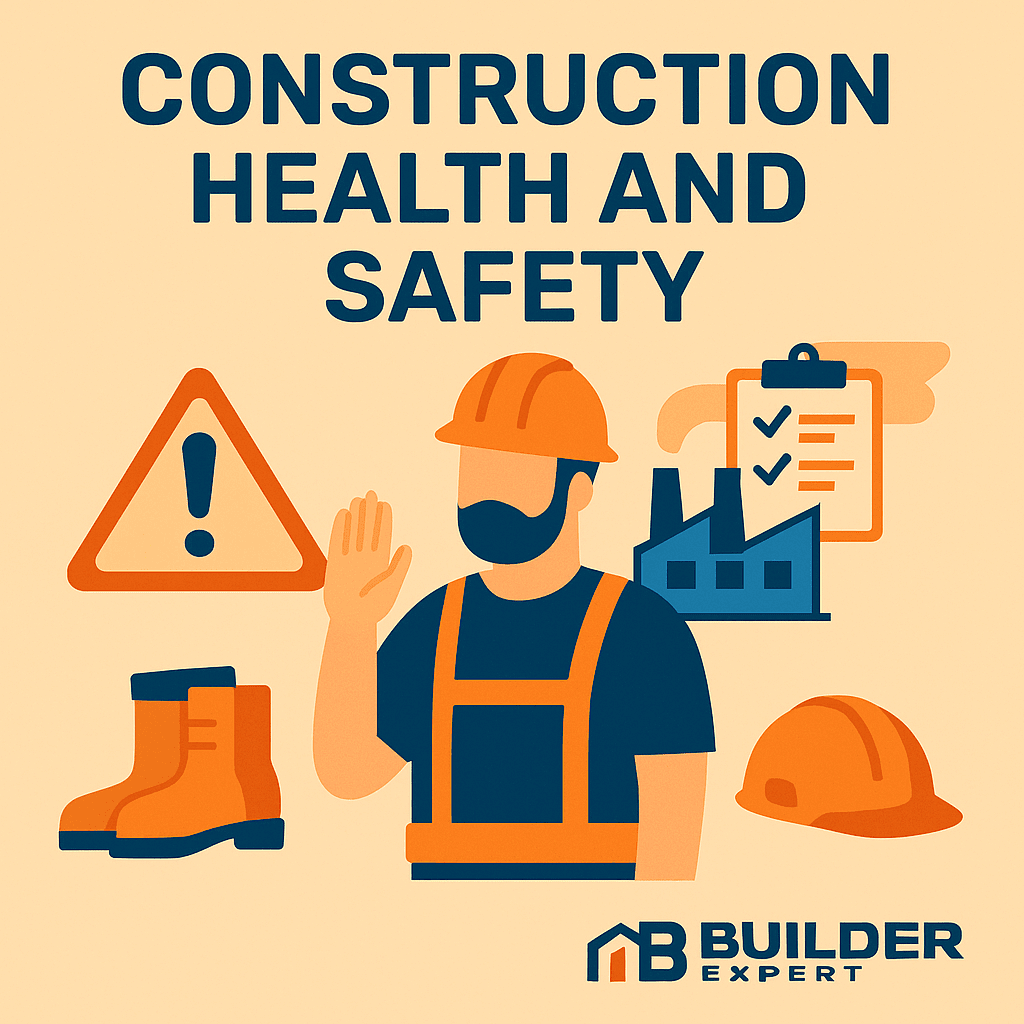.The UK construction industry is one of the most dynamic and fast-paced sectors in the economy. Yet it is also one of the most dangerous. With heavy machinery, high-risk environments, and complex project workflows, construction sites remain among the most accident-prone workplaces. That’s why construction health and safety is not just a compliance issue — it’s a moral responsibility and a cornerstone of professionalism.
For builders, strong health and safety practices go beyond meeting legal obligations. They protect workers, reassure clients, prevent costly delays, and safeguard profits. In today’s competitive environment, where clients expect transparency and accountability, a robust approach to construction health and safety can make the difference between winning contracts and losing them.

This guide will explain why safety is critical, the legal requirements builders must follow, the most common risks on UK construction sites, and how both preventive practices and digital tools support better outcomes.
Section 1: What Is Construction Health and Safety?
At its core, construction health and safety refers to the systems, policies, and practices that protect workers, subcontractors, clients, and the public from harm during building projects. It covers everything from risk assessments and protective equipment to training and compliance with national standards.
The goal is twofold:
- Prevent accidents and injuries through proactive management.
- Create safe, efficient workplaces that allow projects to run smoothly.
Strong health and safety culture isn’t just about following rules. It’s about fostering an environment where workers feel confident, clients feel reassured, and projects progress without avoidable interruptions.
Section 2: The Legal Framework in the UK
In the UK, construction health and safety is governed by strict regulations. Builders who ignore them risk severe penalties, legal disputes, or worse, accidents that damage lives and reputations.
2.1 The Health and Safety at Work Act 1974
This act places a duty on employers to ensure, as far as reasonably possible, the health, safety, and welfare of employees and anyone affected by their work.
2.2 The Construction (Design and Management) Regulations 2015 (CDM Regulations)
The CDM Regulations are central to UK construction safety. They set out roles and responsibilities for all parties, including clients, designers, and contractors, ensuring safety is considered at every project stage.
2.3 Health and Safety Executive (HSE)
The HSE is the UK’s national regulator for workplace safety. They provide guidance, conduct inspections, and enforce regulations. Builders who fail to meet standards can face heavy fines or prosecution.
For modern builders, compliance with these regulations isn’t optional. It’s a legal requirement and a professional necessity.
Section 3: Common Health and Safety Risks in Construction
Understanding the risks is the first step to managing them. The most common hazards in UK construction include:
- Falls from height: Still the leading cause of fatal injuries on construction sites.
- Falling objects: Tools, materials, or debris can easily injure workers or passers-by.
- Manual handling injuries: Lifting, carrying, or repetitive strain can cause long-term health problems.
- Machinery accidents: Heavy equipment poses risks without proper training and safeguards.
- Electrocution and fire hazards: Poorly managed electrical systems and flammable materials increase danger.
- Site access and traffic management issues: Collisions and unsafe site layouts are frequent problems.
A robust construction health and safety plan identifies these risks early and implements measures to control or eliminate them.
Section 4: The Role of Compliance in Client Trust
For many clients, hiring a builder isn’t just about cost — it’s about confidence. A contractor who demonstrates a commitment to construction health and safety signals professionalism and reliability.
- Proof of compliance: Clients often request evidence of risk assessments, training records, or certifications before awarding contracts.
- Transparency builds trust: Safety documents show that a builder has thought through every aspect of the project, reducing the risk of surprises.
- Insurance and liability: Demonstrating compliance also reassures clients that builders are covered by insurance and won’t expose them to unnecessary risks.
In short, prioritising safety isn’t just good practice — it’s a selling point that helps secure more work.
Section 5: Accident Prevention Best Practices
Preventing accidents requires a proactive, structured approach. Some of the best practices for UK builders include:
- Conducting thorough risk assessments before starting work.
- Providing personal protective equipment (PPE) such as helmets, gloves, and safety boots.
- Ensuring worker training in both technical skills and safety procedures.
- Implementing clear site management systems for traffic, access, and storage.
- Regularly monitoring and reviewing safety practices to address new risks.
- Encouraging a safety-first culture where workers feel empowered to raise concerns.
The builders who excel in safety aren’t necessarily those with the most resources, but those who consistently apply these principles.
Section 6: Digital Tools Supporting Safety
Technology is transforming construction health and safety. While insurance and compliance remain critical, digital systems make it easier to plan safely, track risks, and reassure clients.
For example:
- Bill of Quantity Estimates: Detailed breakdowns ensure resources like scaffolding, safety barriers, and PPE are accounted for from the start.
- Real-Time Pricing: Accurate costs prevent safety corners from being cut due to underestimated budgets.
- Detailed Estimates: Professional reports demonstrate planning rigour, reinforcing client trust.
- On-Site Estimates: Enable quick adjustments to budgets if new safety measures are needed mid-project.
- Profit Per Version: Allows builders to compare scenarios, balancing client affordability with investment in stronger safety practices.
- Estimate Tasks Breakdown: Improves visibility, ensuring safety-related tasks are never overlooked.
By integrating digital estimating with safety planning, builders create a system that minimises risk while maximising client confidence.
Section 7: Case Studies and Lessons Learned
Real-world examples show why construction health and safety can’t be ignored:
- A small contractor fined thousands after failing to provide fall protection, leading to serious injury.
- A large developer praised for implementing digital safety checklists that reduced accident rates by 40%.
- Builders who factored in PPE and safety training costs upfront through detailed estimating avoided disputes over “unexpected” costs later.
These cases highlight a simple truth: safety is cheaper, smarter, and more professional than risk.
Section 8: The Cost of Neglect vs. the Benefits of Safety
Neglecting construction health and safety has heavy costs:
- Financial penalties from HSE.
- Compensation claims from injured workers.
- Delays caused by site closures.
- Long-term reputational damage.
By contrast, the benefits of safety are powerful:
- Higher client trust.
- More efficient workflows.
- Reduced insurance premiums.
- Stronger profit margins through fewer disruptions.
Safety isn’t a cost — it’s an investment that pays back in multiple ways.
Conclusion: Why Construction Health and Safety Matters More Than Ever
In today’s UK building industry, construction health and safety is more than compliance — it’s the foundation of professionalism, profitability, and trust. By preventing accidents, complying with regulations, and reassuring clients, safety practices protect both people and projects.
With the support of digital tools like BuilderExpert’s construction estimating software, builders can integrate safety planning directly into their financial workflows. This ensures that every estimate, contract, and project decision prioritises both efficiency and wellbeing.
The future of UK construction will be led by those who see safety not as a box-ticking exercise, but as a core value. By committing to construction health and safety now, builders can deliver projects that are not only successful but sustainable for the long term.
✅ Ready to take your projects to the next level? Start integrating safety and digital estimating today with BuilderExpert.
Stay Connected with BuilderExpert
- Facebook: https://www.facebook.com/builderexpertuk
- LinkedIn: https://www.linkedin.com/in/builderexpert/
- YouTube: https://www.youtube.com/@BuilderExpert_Uk

